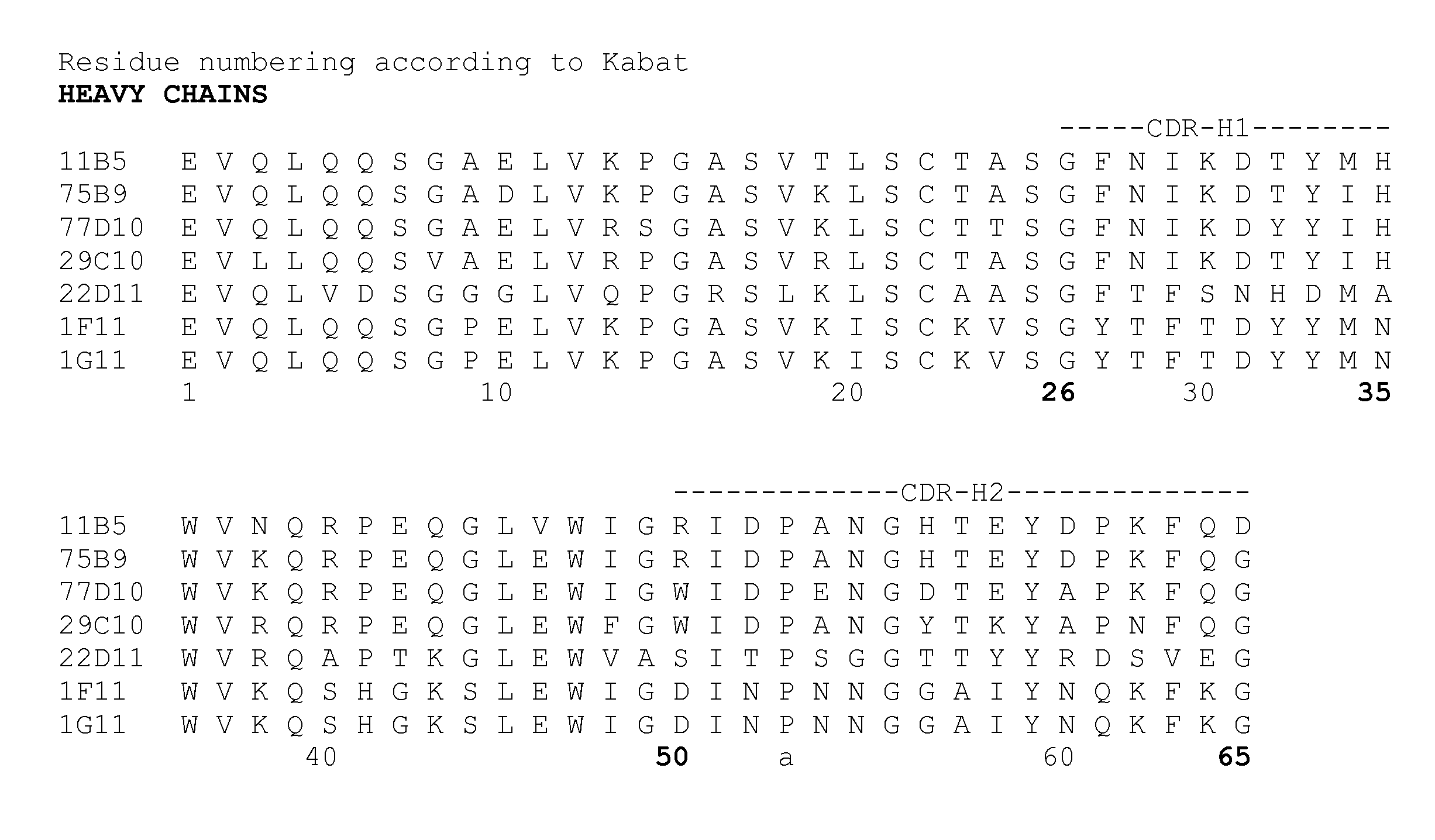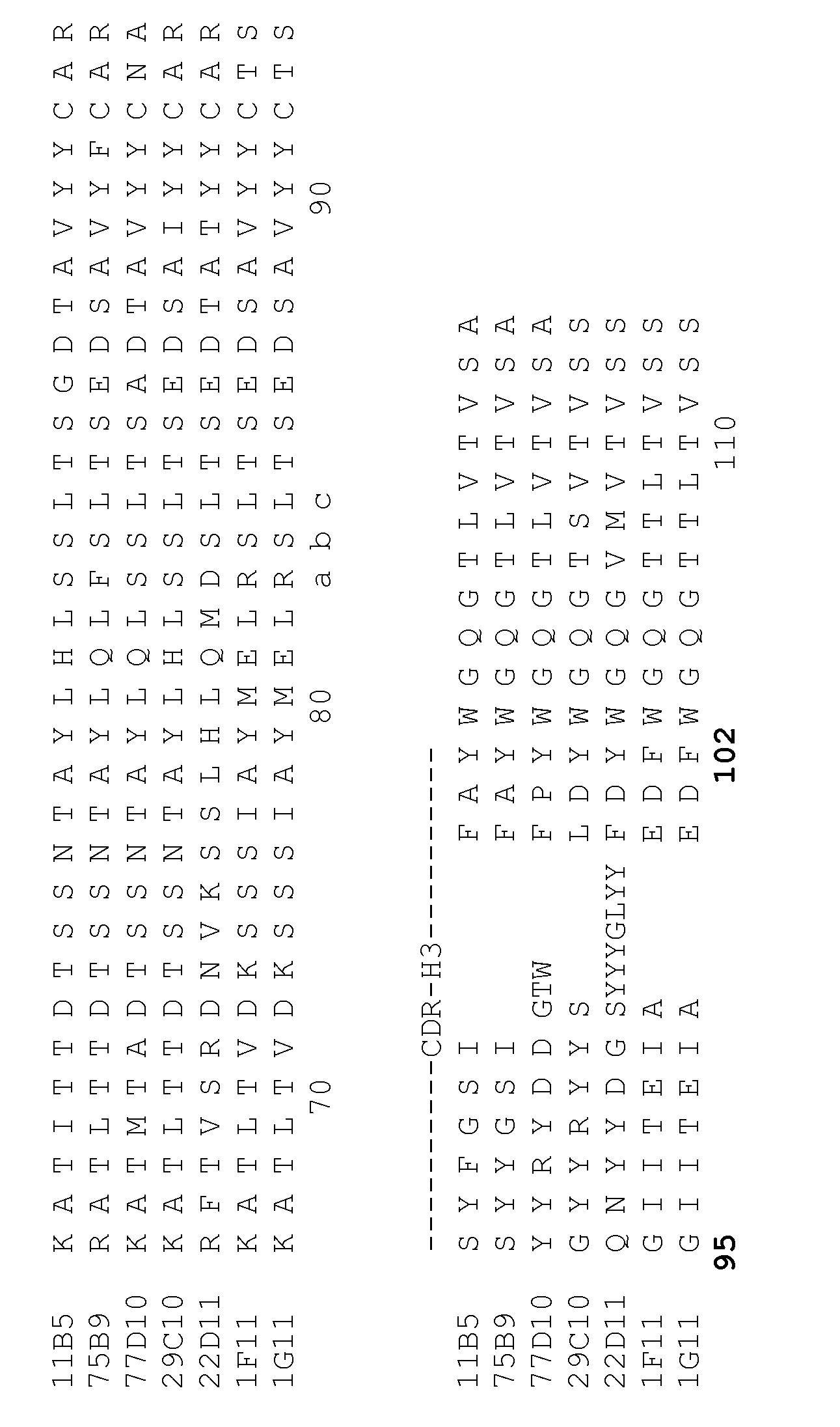Anti-pcsk9 and methods for treating lipid and cholesterol disorders
a technology of lipid and cholesterol disorders and antibodies, applied in the field of cholesterol homeostasis treatment disorders, can solve the problems of difficult and difficult inhibition of large protein interactions (i.e., protein-protein interactions or ppi), and the disadvantage of using antibodies or small molecule inhibitors, and it is not likely that a given antibody or small molecule inhibitor will successfully block their binding
- Summary
- Abstract
- Description
- Claims
- Application Information
AI Technical Summary
Benefits of technology
Problems solved by technology
Method used
Image
Examples
example 1
Soluble EGF-A Domain of the LDL Receptor or Anti-PCSK9 Antibody Blocks the LDLR-PCSK9 Interaction
[0136]In this example, a soluble peptide encoding the EGF-A domain of the human LDL receptor as well as various anti-PCSK9 antibodies are shown to block interactions between PCSK9 and the receptor.
[0137]The following are the AlphaScreen methods and materials for the antibody and EGF-A inhibition of PCSK9-LDLR interaction experiments:
[0138]Purified PCSK9 carrying a C-terminal FLAG tag was purified from HEK293 cells stably expressing PCSK9. Purity was estimated, by silver staining, at greater than >90%. Anti-PCSK9-catalytic domain antibody was purchased from Cayman Chemical (Rabbit anti-murine-PCSK9 polyclonal antibody, Cayman Chemical; Ann Arbor, Mich.; Cat.#10008811). This rabbit anti-mouse / human PCSK9-catalytic domain antibody recognizes an epitope with the following amino acid sequence: VFAQSIPWNLER (SEQ ID NO: 8). A rabbit anti-human PCSK9 C-terminal domain antibody (which binds speci...
example 2
Anti-PCSK9 Antibody Treatment of Cells Leads to Enhanced LDL Uptake
[0144]Incubation of cells with soluble PCSK9 leads to a decrease in the ability of the cells to absorb and clear low density lipoprotein (LDL) from the medium. This example demonstrates that inhibition of PCSK9 with an anti-PCSK9 antibody antagonizes this effect of PCSK9 and leads to increased levels of LDL uptake and clearance.
[0145]The uptake assays were performed as follows: HepG2 cells at 10,000 cells / well in 384 Collagen 1 coated plate were seeded and grown overnight. On the next day, a serial dilution of bacu-PCSK9-WT in MEM-1% BSA was made, mixing with a fixed concentration of anti-mouse-cat domain PCSK9 polyclonal antibody (Cayman Chemical; Ann Arbor, Mich.; cat# 10008811; raised against mouse PCSK9 antigen VFAQSIPWNLER (SEQ ID NO: 8) and cross reacts with human PCSK9) or anti-human PCSK9 polyclonal antibody (R&D Systems, Minneapolis, Minn.; cat# AF3888) at a final concentration of 100 ug / ml respectively. The...
example 3
Characterization of Anti-PCSK9 Antibodies
[0147]The 75B9, 77D10, 11B5, 22D11, 1F11 / 1G11 and 29C10 anti-PCSK9 antibodies were characterized. The antibodies were found to effectively inhibit interaction between PCSK9 and the LDL receptor as well as inhibit PCSK9-mediated LDL receptor degradation. In vivo, the antibodies were found to inhibit PCSK9 and, thereby increase the levels of LDL receptor present. Moreover, the antibodies neutralized the in vivo cholesterol increase observed when exogenous PCSK9 was added.
Inhibition of PCSK9-Mediated LDLR Degradation with anti-PCSK9 Antibodies,
[0148]The 75B9, 77010, 11B5, 22011, 1F11 / 1G11 and 29C10 antibodies were evaluated in an in-cell western assay for their ability to inhibit the degradation of the LDL receptor by PCSK9 in HepG2 cells.
[0149]In-cell western was performed to quantitate anti-PCSK9 antibody inhibition of PCSK9-mediated LDLR degradation. HepG2 cells were seeded in 384-well collagen coated plates and treated with anti-PCSK9 antibo...
PUM
| Property | Measurement | Unit |
|---|---|---|
| Fraction | aaaaa | aaaaa |
| Fraction | aaaaa | aaaaa |
| Chemotherapeutic properties | aaaaa | aaaaa |
Abstract
Description
Claims
Application Information
 Login to View More
Login to View More - R&D
- Intellectual Property
- Life Sciences
- Materials
- Tech Scout
- Unparalleled Data Quality
- Higher Quality Content
- 60% Fewer Hallucinations
Browse by: Latest US Patents, China's latest patents, Technical Efficacy Thesaurus, Application Domain, Technology Topic, Popular Technical Reports.
© 2025 PatSnap. All rights reserved.Legal|Privacy policy|Modern Slavery Act Transparency Statement|Sitemap|About US| Contact US: help@patsnap.com



